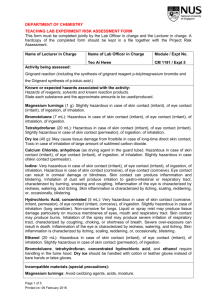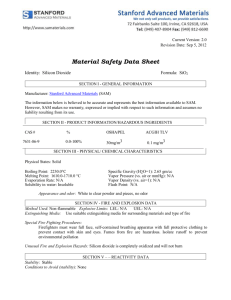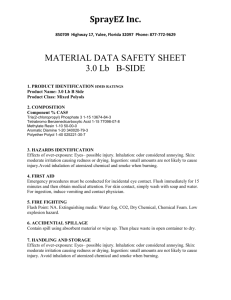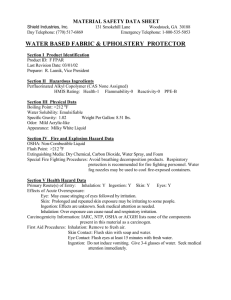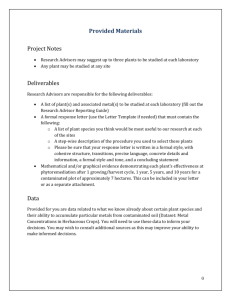DEPARTMENT OF CHEMISTRY TEACHING LAB EXPERIMENT
advertisement
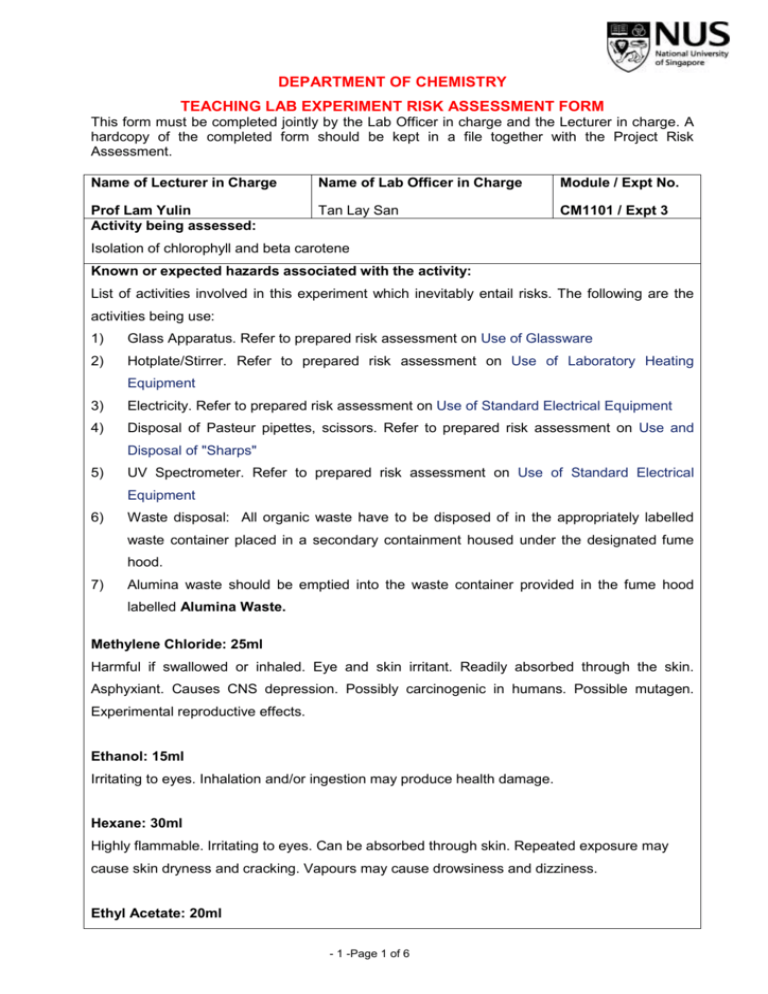
DEPARTMENT OF CHEMISTRY TEACHING LAB EXPERIMENT RISK ASSESSMENT FORM This form must be completed jointly by the Lab Officer in charge and the Lecturer in charge. A hardcopy of the completed form should be kept in a file together with the Project Risk Assessment. Name of Lecturer in Charge Name of Lab Officer in Charge Module / Expt No. Prof Lam Yulin Activity being assessed: Tan Lay San CM1101 / Expt 3 Isolation of chlorophyll and beta carotene Known or expected hazards associated with the activity: List of activities involved in this experiment which inevitably entail risks. The following are the activities being use: 1) Glass Apparatus. Refer to prepared risk assessment on Use of Glassware 2) Hotplate/Stirrer. Refer to prepared risk assessment on Use of Laboratory Heating Equipment 3) Electricity. Refer to prepared risk assessment on Use of Standard Electrical Equipment 4) Disposal of Pasteur pipettes, scissors. Refer to prepared risk assessment on Use and Disposal of "Sharps" 5) UV Spectrometer. Refer to prepared risk assessment on Use of Standard Electrical Equipment 6) Waste disposal: All organic waste have to be disposed of in the appropriately labelled waste container placed in a secondary containment housed under the designated fume hood. 7) Alumina waste should be emptied into the waste container provided in the fume hood labelled Alumina Waste. Methylene Chloride: 25ml Harmful if swallowed or inhaled. Eye and skin irritant. Readily absorbed through the skin. Asphyxiant. Causes CNS depression. Possibly carcinogenic in humans. Possible mutagen. Experimental reproductive effects. Ethanol: 15ml Irritating to eyes. Inhalation and/or ingestion may produce health damage. Hexane: 30ml Highly flammable. Irritating to eyes. Can be absorbed through skin. Repeated exposure may cause skin dryness and cracking. Vapours may cause drowsiness and dizziness. Ethyl Acetate: 20ml - 1 -Page 1 of 6 Hazardous in case of ingestion, of inhalation. Slightly hazardous in case of skin contact (irritant, permeator), of eye contact (irritant). Alumina: 10gm To avoid breathing the dust. *amount stated are computed for the whole experiment. Incompatible materials (special precautions): Methylene Chloride: Al, Mg powders, K & Na; conc. HNO3. Incompatible Materials: Reactive with oxidizing agents, metals. Hazardous Decomposition Products: These products are halogenated compounds. Ethanol : Segregate from strong oxidisers peroxides and alkali metals e.g. sodium, potassium, lithium. Incompatible with aluminium. DO NOT heat above 49ºC in aluminium equipment. Hexane: Reactive with oxidizing agents. Ethyl Acetate: Conditions to be avoided: Heating. Substances to be avoided: Alkali metals, fluorine, hydrides, strong oxidizing agents, water with air and light, fuming sulphuric acid, lithium aluminium hydride, chlorosulfonic acid. Further information: Highly inflammable; light-sensitive; sensitive to air; unsuitable working materials: various plastics. Explosive with air in a vaporous/gaseous state. Alumina: Substances to be avoided: Halogen-halogen compounds, halogen oxides, ethylene oxide, fluorine, hydrogen halides, nitrates, vinyl acetate. The risk of injury and its severity likely to arise from these hazards: Methylene Chloride: Skin Contact: Hazardous (sensitizer, irritant). Skin inflammation is characterized by itching, scaling, reddening, or, occasionally, blistering. Eye Contact: Extremely hazardous (irritant). Inflammation of the eye is characterized by redness, watering, and itching. Inhalation: Hazardous (lung irritant). Ingestion: Hazardous. Aggravated by Overexposure: To a highly toxic material may produce general deterioration of - 2 -Page 2 of 6 health by an accumulation in one or many human organs. Ethanol, Hexane : Skin Contact: Hazardous in case of skin contact (irritant). Skin inflammation is characterized by itching, scaling, reddening, or, occasionally, blistering. Eye Contact: Hazardous in case of eye contact (irritant). Inflammation of the eye is characterized by redness, watering, and itching. Inhalation: Hazardous in case of inhalation (lung irritant). Ingestion: Extremely hazardous in case of ingestion. May be fatal if swallowed. Aggravated by Overexposure: Repeated exposure to a highly toxic material may produce general deterioration of health by an accumulation in one or many human organs. Ethyl Acetate: Skin Contact: Drying-out effect resulting in rough and chapped skin. Eye Contact: Irritations. After Ingestion and Inhalation: Mucosal irritations, lack of appetite, headache, drowsiness. In high concentrations: Salivation, nausea, vomiting, narcosis, respiratory paralysis. Long-term exposure: Sensitization possible in predisposed persons. After accidental swallowing the substance may pose a risk of aspiration. Passage into the lung (vomiting!) can result in a condition resembling pneumonia (chemical pneumonitis). Alumina: Skin & Eye Contact: No irritation. Inhalation of dust: Metal –fume fever after inhalation of large quantities. Ingestion: Only very slightly absorbable via the gastrointestinal tract. Who is at risk? Person performing the experiment and those in the vicinity. Measure to be taken to reduce the level of risk: Proper laboratory attire and safety measures must always be used in order to reduce the level of risk. Wash hands thoroughly after handling. Do not take internally. Eye wash and safety equipment should be readily available. Eye protection: Chemical safety goggles. Hand protection: Gloves. Refer to prepared PSSO SAFETY Information Center website: http://www.chemistry.nus.edu.sg/PSSO/index.htm#undergrad Training prerequisites: This assessment should be read by everyone who will be using the above mentioned - 3 -Page 3 of 6 chemicals. Refer to Completed Risk Assessment forms for common activities: http://www.chemistry.nus.edu.sg/PSSO/safety/risk/risk.htm#Common Level of risk remaining: The level of risk is low although constant vigilance is necessary to avoid injury. Emergency action if : Spill: Methylene Chloride, Ethyl Acetate, Hexane & Ethanol: Small Spill & Leak: Absorb with an inert material and put the spilled material in an appropriate waste disposal. Large Spill & Leak: Keep away from heat. Keep away from sources of ignition. Stop leak if without risk. Absorb with DRY earth, sand or other non-combustible material. Do not get water inside container. Do not touch spilled material. Use water spray to reduce vapors. Prevent entry into sewers, basements or confined areas; dike if needed. Alumina: Small Spill & Leak:Use appropriate tools to put the spilled solid in a convenient waste disposal container. Finish cleaning by spreading water on the contaminated surface and dispose of according to local and regional authority requirements. Large Spill & Leak: Use a shovel to put the material into a convenient waste disposal container. Fire: Methylene Chloride, Ethyl Acetate, Hexane & Ethanol: Fire Hazards in Presence of Various Substances: Flammable in presence of open flames, sparks and static discharge, of shocks, of heat, of oxidizing materials. Small Fire: Use DRY chemical powder. Large Fire: Use alcohol foam, water spray or fog. Cool containing vessels with water jet in order to prevent pressure build-up, autoignition or explosion. Is the experiment suitable for out-of-hours operation? Yes No References if any: Refer to the following MSDS for more information Methylene Chloride: http://www.sciencelab.com/msds.php?msdsId=9926060 Ethyl Acetate: http://www.sciencelab.com/msds.php?msdsId=9927165 Ethanol: http://www.sciencelab.com/msds.php?msdsId=9923956 n-Hexane: http://www.cpchem.com/msds/100000000434_SDS_KR_EN.PDF Alumina: http://www.sciencelab.com/msds.php?msdsId=9925577 - 4 -Page 4 of 6 Signature of Lab Officer in Charge:……………………………………………………………….. Date:………………………… Signature of Lecturer in Charge:………… …………………………………….. Date:… …………………….. Prepared Risks Assessments for standard equipment and operation are with the kind permission of Dr. Ken MacNeil, School of Chemistry, University of Bristol. - 5 -Page 5 of 6 Activity being assessed: Note any activity to be used which entail risk (e.g. use of glass vacuum apparatus, high pressures, high voltage, radiation, high temperatures). Give reference to any special protocols to be followed, and if appropriate attach copies to the risk assessment form. State any additional precautions taken to minimise risk. Known or expected hazards associated with the activity: FOR EACH CHEMICAL, read the MSDS and note:a) Particular hazards (e.g. highly toxic, carcinogenic, corrosive, flammable, pyrophoric, explosive, volatile, dust hazard). Note any dangerous combinations of properties (e.g. volatile and toxic). b) Requirements for safe handling (e.g. fume cupboard, inert atmosphere, low temperature). c) How to dispose of residuals Dispose to drain, with water dilution Neutralise, then to drain with suitable dilution To flammable liquid waste receptacle To non-flammable liquid waste receptacle Keep for recovery/recycling Keep for special disposal later (e.g. heavy metals) Double bag and dispose to dry waste Special procedure (specify) Incompatible materials (special precautions) Note any dangerously incompatible materials and hazards arising from contact of any reagents and substances used with common materials such as paper, benches, hoses, etc. Measures to be taken to reduce the level of risk Include hazards of previously unknown products. Location of work – laboratory, open bench, fume cupboard Level of risk remaining: Likelihood and consequences of any accident or unforeseen events whilst carrying out the activity. When this has been done, choose the appropriate procedure:a) Close supervision and/or attendance of trained first-aider needed. b) Specific approval of supervisor needed. c) Training is needed prior-to or during the operations specified. d) Training is complete and only general laboratory competence required. e) No risk perceived. Emergency action: a) Any special requirements to deal with accidental spillage or leakage. b) What to do in the event of accidental exposure (skin contact, inhalation, etc.). - 6 -Page 6 of 6


